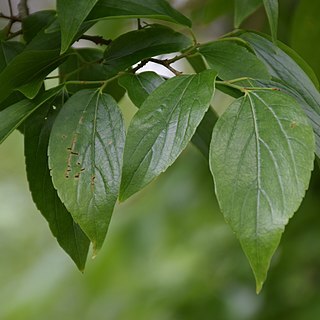Trees, to 30 m tall, deciduous or sometimes evergreen. Bark grayish white. Branchlets densely yellowish brown pubescent when young, brown, usually glabrescent with age; lenticels few or none. Winter buds brown, 1-3 mm; scales glabrous, margin ciliate. Stipules narrowly lanceolate, caducous, to 7 mm, never enclosing buds. Petiole 6-13 mm, brown, broadly sulcate, puberulous at least near adaxial furrow; leaf blade ovate-elliptic, ovate-lanceolate, or ± rhombic, 5-13 × 2.5-5.5 cm, thickly papery to ± papery, abaxially usually inconspicuously yellowish brown puberulent when young, with hairs scattered on major veins and sometimes tufted in vein axils with age, base oblique with one side ± rounded and other cuneate, margin entire or obtusely serrate, teeth 0-13 on each side, apex acuminate to shortly caudate-acuminate; secondary veins 3 or 4 on each side of midvein. Flowers fascicled, occasionally in racemes of 2 or 3 flowers. Style branches linear, undivided. Infructescences unbranched or seldom forked, rarely showing a small scar from a fallen male flower, 1-3 per leaf axil, rather slender, glabrous or pubescent, 0.8-1.5 cm; fruiting pedicel 1 or 2 × as long as subtending petiole. Drupe yellow to orange when mature, ± globose, 7-8 mm in diam. Stone ± globose, ca. 5 mm in diam., 4-ribbed. Fl. Mar-Apr, fr. Sep-Oct.
A medium sized tree that loses its leaves during the year. It grows 15 m high. It has a short thick trunk. The crown is spreading. The bark is bluish-grey. It is smooth and speckled with raised white dots. Old trees develop horizontal wrinkles. Young leaves are pale green. They become dark green later and turn yellow before falling. The leaves are 8-12 cm long on short stalks. There are teeth along a part of the leaf edge. They are pointy at the tip and have 3 veins at the base. The flowers are small and green. Flowers can be male, female or of both sexes. They are in the axils of the leaves at the end of longer stalks. Male and bisexual flowers are at the base of short stalks below the leaves. The fruit are small and berry-like. They are green and turn orange-red. They are the size of a peppercorn and eventually turn black.


